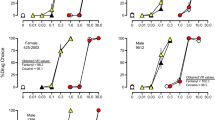Abstract
Eight rhesus monkeys (Macaca mulata) were trained to self-administer orally delivered ethanol (8%) and saccharin (0.03 or 0.3% wt/vol) or water under concurrent fixed-ratio (FR) schedules. The FR requirement for saccharin was fixed at 32, while the FR for ethanol was varied (4, 8, 16, 32, 64 and 128) in a nonsystematic order to assess demand for drug. Demand was defined as consumption plotted as a function of price (FR). Income was defined as the duration of access to available resources. Income was varied by allowing access to the concurrently available liquids 20, 60 or 180 min per day. Order of testing was counter-balanced across monkeys. Saccharin deliveries were much higher than ethanol deliveries under the 180-min income condition; however, they were lower than ethanol deliveries when income was reduced to 20 min and the ethanol FR was 4, 8 or 16. Thus, when the price of drug was relatively low, consumption of drug exceeded that of the nondrug reinforcer, and that relationship was reversed as income decreased. Saccharin deliveries sustained a proportionally greater reduction due to decreased income compared to ethanol deliveries. As income decreased from 180 to 20 min, saccharin deliveries were reduced by an average of 79.1% (across ethanol FR conditions) while ethanol deliveries were reduced by an average of 41.2 and 40.8% when concurrent saccharin or water were available, respectively; thus, drug self-administration was more resistant to income changes than saccharin. The demand for ethanol was shifted downward in a parallel fashion as income decreased. As ethanol cost (FR) increased, there were proportionately greater decreases in ethanol intake when saccharin was concurrently available compared to when water was available. There was a 35–50% reduction in ethanol deliveries due to concurrent saccharin (versus water) at FR 4, compared to a 55–75% reduction at FR 128. Cost of ethanol (FR), income level and the availability of a nondrug reinforcer are all variables that modify ethanol-reinforced behavior, and income alters the relative preference for a drug versus nondrug reinforcer.
Similar content being viewed by others
References
Carroll ME (1985) Concurrent phencyclidine and saccharin access: presentation of an alternative reinforcer reduces drug intake. J Exp Anal Behav 43:131–144
Carroll ME, Meisch RA (1984) Increased drug-reinforced behavior due to food deprivation. In: Thompson T, Dews PB, Barrett JE (eds) Advances in behavioral pharmacology, vol. 4. Academic Press, New York, pp 47–88
Carroll ME, Rodefer JS (1993) Income alters choice between drug and an alternative nondrug reinforcer in monkeys. Exp Clin Psychopharmacol 1:110–120
Carroll ME, Santi PA, Rudell RL (1981) A microcomputer system for the control of behavioral experiments. Pharmacol Biochem Behav 4:415–417
Carroll ME, Lac ST, Nygaard SL (1989) A concurrently available nondrug reinforcer prevents the acquisition or decreases the maintenance of cocaine-reinforced behavior. Psychopharmacology 91:23–29
Carroll ME, Carmona GN, May SA (1991) Modifying drug-reinforced behavior by altering the economic conditions of the drug and nondrug reinforcer. J Exp Anal Behav 56:361–376
DeGrandpre RJ, Bickel WK, Rizvl SAT, Hughes JR (1993) The behavioral economics of drug self-administration: VII. Effects of income on drug choice in humans. J Exp Anal Behav 59:483–500
Dworkin SI, Mirkis S, Smith JE (1990) Reinforcer interactions under concurrent schedules of food, water and intravenous cocaine. Behav Pharmacol 1:327–338
Elsmore TF, Fletcher GV, Conrad DG, Sodetz FJ (1980) Reduction of heroin intake in baboons by an economic constraint. Pharmacol Biochem Behav 12:729–731
Guide for the Care and Use of Laboratory Animals (1985) NIH Publication No. 85-23, US Government Printing Office, Washington DC
Hastjarjo T, Silberberg A (1992) Effects of reinforcer delays on choice as a function of income level. J Exp Anal Behav 57:119–125
Henningfield JE, Meisch RA (1976) Drinking device for rhesus monkeys. Pharmacol Biochem Behav 4:609–610
Hursh SK (1991) Behavioral economics of drug self-administration and drug abuse policy. J Exp Anal Behav 56:377–393
Hursh SK, Bauman RA (1987) The behavioral analysis of demand. In: Green L, Kagel JH (eds) Advances in behavioral economics, vol. 1. Advances in Behavioral Sciences Series, Ablex Publishing Corp., Norwood, N.J., pp 117–165
Lea SEG, Tarpy RM, Webley P (1987) The individual in the economy. Cambridge University Press, Cambridge, UK
Macenski MJ, Cutrell EB, Meisch RA (1993) Concurrent pentobarbital-and saccharin-maintained responding: effects of saccharin concentration and schedule conditions. Psychopharmacology 112:204–210
Meisch RA, Henningfield JE (1977) Drinking of ethanol as a reinforcer for rhesus monkeys via the oral route: Initial results. In: Gross MM (ed) Advances in experimental medicine and biology, vol. 85B: Alcohol intoxication and withdrawal-IIIb: studies in alcohol dependence. Plenum Press, New York, pp 443–463
Nader MA, Woolverton WL (1991) Effects of increasing the magnitude of an alternative reinforcer on drug choice in a discretetrail choice procedure. Psychopharmacology 105:169–174
Samson HH, Roehrs TA, Tolliver GA (1982) Ethanol reinforced responding in the rat: a concurrent analysis using sucrose as the alternate choice. Pharmacol Biochem Behav 17:333–339
Schwarz-Stevens K, Samson HH, Tolliver GA, Lumeng L, Li TK (1991) The effects of ethanol initiation procedures on ethanol reinforced behavior in the alcohol-preferring rat. Alcohol Clin Exp Res 15:277–285
Shurtleff D, Warren-Boulton FR, Asano T (1987) Income and choice between different goods. J Exp Anal Behav 48:263–275
Silberberg A, Warren-Boulton FR, Asano T (1987) Inferior-good and Giffen-good effects in monkey choice behavior. J Exp Psychol [Anim Behav] 13:292–301
Author information
Authors and Affiliations
Rights and permissions
About this article
Cite this article
Carroll, M.E., Rodefer, J.S. & Rawleigh, J.M. Concurrent self-administration of ethanol and an alternative nondrug reinforcer in monkeys: effects of income (session length) on demand for drug. Psychopharmacology 120, 1–9 (1995). https://doi.org/10.1007/BF02246139
Received:
Revised:
Issue Date:
DOI: https://doi.org/10.1007/BF02246139




